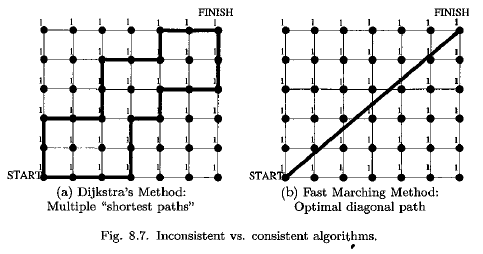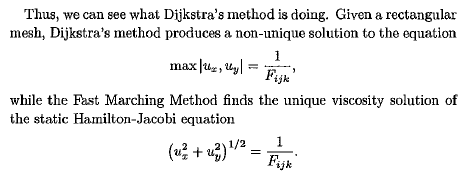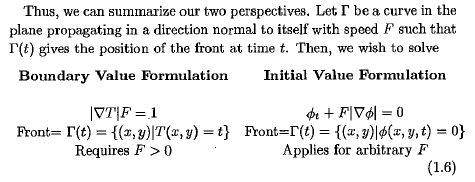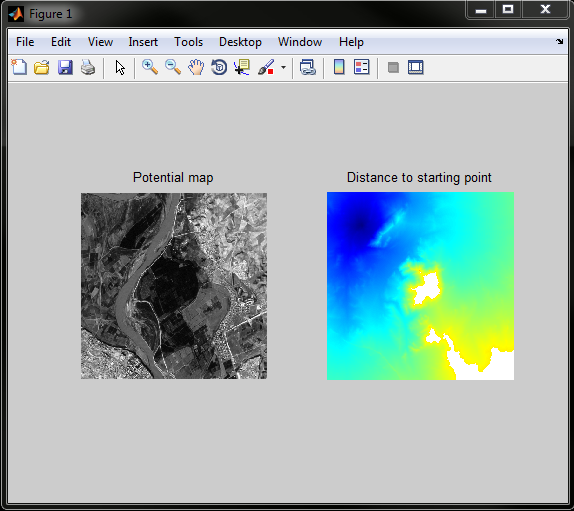Fast Marching method 跟 dijkstra 方法類似,只不過dijkstra方法的路徑只能沿網格,而Fast Marching method的方法可以沿斜線.
[Level Set Methods and Fast Marching Methods p94-95


]
這裏
然後就可以跟Boundary Value Formulation對應起來了.
[Level Set Methods and Fast Marching Methods p7

]
本例,首先加載一張灰度圖片, 將裏面像素的值W作為該點的流速F. 然後算到達該點的時間,也就是程序裏面的距離D.
matlab部分源代碼如下:
example1.m
n = 400; [M,W] = load_potential_map('road2', n); %start_point = [16;219]; %end_point = [394;192]; % You can use instead the function [start_point,end_point] = pick_start_end_point(W); clear options; options.nb_iter_max = Inf; options.end_points = end_point; % stop propagation when end point reached [D,S] = perform_fast_marching(W, start_point, options); % nicde color for display A = convert_distance_color(D); imageplot({W A}, {'Potential map' 'Distance to starting point'}); colormap gray(256);
perform_front_propagation_2d_slow.m
function [D,S,father] = perform_front_propagation_2d_slow(W,start_points,end_points,nb_iter_max,H) % [D,S] = perform_front_propagation_2d_slow(W,start_points,end_points,nb_iter_max,H); % % [The mex function is perform_front_propagation_2d] % % 'D' is a 2D array containing the value of the distance function to seed. % 'S' is a 2D array containing the state of each point : % -1 : dead, distance have been computed. % 0 : open, distance is being computed but not set. % 1 : far, distance not already computed. % 'W' is the weight matrix (inverse of the speed). % 'start_points' is a 2 x num_start_points matrix where k is the number of starting points. % 'H' is an heuristic (distance that remains to goal). This is a 2D matrix. % % Copyright (c) 2004 Gabriel Peyr? data.D = W.*0 + Inf; % action 先把所有點的距離標為Inf start_ind = sub2ind(size(W), start_points(1,:), start_points(2,:)); data.D( start_ind ) = 0; %將起點的距離設置為0 data.O = start_points; % 將起點加入Open list % S=1 : far, S=0 : open, S=-1 : close data.S = ones(size(W));% 將所點的狀態設為Far data.S( start_ind ) = 0; % 將起點的狀態設為open(trial) data.W = W; data.father = zeros( [size(W),2] );% father維度400*400*2,父節點有兩個,因為走斜線 verbose = 1; if nargin<3 end_points = []; end if nargin<4 nb_iter_max = round( 1.2*size(W,1)^2 ); end if nargin<5 data.H = W.*0; else if isempty(H) data.H = W.*0; else data.H = H; end end if ~isempty(end_points) end_ind = sub2ind(size(W), end_points(1,:), end_points(2,:)); else end_ind = []; end str = 'Performing Fast Marching algorithm.'; if verbose h = waitbar(0,str); end i = 0; while i<nb_iter_max && ~isempty(data.O) && isempty( find( data.S(end_ind)==-1 ) ) i = i+1; data = http://blog.csdn.net/seamanj/article/details/perform_fast_marching_step(data); if verbose waitbar(i/nb_iter_max, h, sprintf('Performing Fast Marching algorithm, iteration %d.', i) ); end end if verbose close(h); end D = data.D; S = data.S; father = data.father; function data1 = perform_fast_marching_step(data) % perform_fast_marching_step - perform one step in the Fast Marching algorithm % % data1 = perform_fast_marching_step(data); % % Data is a structure that records the state before/after a step % of the FM algorithm. % % Copyright (c) 2004 Gabriel Peyr? % some constant kClose = -1; kOpen = 0; kFar = 1; D = data.D; % action, a 2D matrix O = data.O; % open list S = data.S; % state, either 'O' or 'C', a 2D matrix H = data.H; % Heuristic W = data.W; % weight matrix, a 2D array (speed function) father = data.father; [n,p] = size(D); % size of the grid, n,p都為400 % step size h = 1/n; if isempty(O)%看開集是否為空 data1 = data; return; end ind_O = sub2ind(size(D), O(1,:), O(2,:));%獲取開集裏面的頂點的索引 [m,I] = min( D(ind_O)+H(ind_O) ); %m裏面是最小值,I裏面是該最小值在被檢測矩陣裏面的索引 I = I(1);%取第一個索引 % selected vertex % 取開集中的第I個點的索引 i = O(1,I); j = O(2,I); O(:,I) = []; % pop from open ,將此點從開集中移除 S(i,j) = kClose; % now its close, 將此點加入閉集(known set)中 % its neighbor % 準備遍歷他的右,上,左,下的鄰近點 nei = [1,0; 0,1; -1,0; 0,-1 ]; for k = 1:4 ii = i+nei(k,1); jj = j+nei(k,2); if ii>0 && jj>0 && ii<=n && jj<=p f = [0 0]; % current father %%% update the action using Upwind resolution P = h/W(ii,jj); % neighbors values a1 = Inf; if ii<n a1 = D( ii+1,jj ); f(1) = sub2ind(size(W), ii+1,jj); end if ii>1 && D( ii-1,jj )<a1 a1 = D( ii-1,jj ); f(1) = sub2ind(size(W), ii-1,jj); end a2 = Inf; if jj<n a2 = D( ii,jj+1 ); f(2) = sub2ind(size(W), ii,jj+1); end if jj>1 && D( ii,jj-1 )<a2 a2 = D( ii,jj-1 ); f(2) = sub2ind(size(W), ii,jj-1); end if a1>a2 % swap to reorder tmp = a1; a1 = a2; a2 = tmp; f = f([2 1]); end % now the equation is (a-a1)^2+(a-a2)^2 = P^2, with a >= a2 >= a1. % 書上95頁公式為:(ux^2 + uy^2)^(1/2)=1/Fijk % u理解為到達點的時間,Fijk理解為在點ijk處的流速 if P^2 > (a2-a1)^2%delta 大於0 delta = 2*P^2-(a2-a1)^2; A1 = (a1+a2+sqrt(delta))/2; else%否則用dijkstra方法,沿著格子走,公式為:max|ux,uy|=1/Fijk A1 = a1 + P; f(2) = 0;%將第2個父節點設為0 end switch S(ii,jj) case kClose%閉集不用更新 % check if action has change. Should not appen for FM if A1<D(ii,jj) % warning('FastMarching:NonMonotone', 'The update is not monotone'); % pop from Close and add to Open if 0 % don't reopen close points O(:,end+1) = [ii;jj]; S(ii,jj) = kOpen; D(ii,jj) = A1; end end case kOpen%開集才更新 % check if action has change. if A1<D(ii,jj) D(ii,jj) = A1; father(ii,jj,:) = f; end case kFar%遠集不僅更新,而且加入開集 if D(ii,jj)~=Inf warning('FastMarching:BadInit', 'Action must be initialized to Inf'); end % add to open O(:,end+1) = [ii;jj]; S(ii,jj) = kOpen; % action must have change. D(ii,jj) = A1; father(ii,jj,:) = f; otherwise error('Unknown state'); end end end data1.D = D; data1.O = O; data1.S = S; data1.W = W; data1.H = H; data1.father = father;
運行結果:

matlab完整源代碼
Tags: function starting instead 源代碼 method
文章來源: